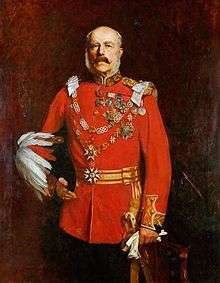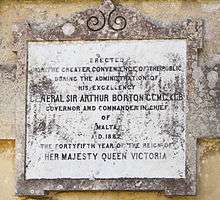Arthur Borton (British Army officer)
| Sir Arthur Borton | |
|---|---|
 Sir Arthur Borton | |
| Born |
20 January 1814 Blofield, Norfolk, England |
| Died |
7 September 1893 London, England |
| Allegiance |
|
| Service/branch |
|
| Years of service | 1832–1884 |
| Rank | General |
| Commands held | Mysore division |
| Battles/wars |
First Anglo-Sikh War Crimean War |
| Awards |
Knight Grand Cross of the Order of the Bath Knight Grand Cross of the Order of St Michael and St George |
| Other work | Governor of Malta |
General Sir Arthur Borton GCB GCMG (20 January 1814 – 7 September 1893) was a British Army officer who became Governor of Malta.
Early life

Borton was born on 20 January 1814 in Blofield, Norfolk where his father John Drew Borton was the rector.[1] His mother was Louisa Carthew one of the daughters of Rev Thomas Carthew of Woodbridge Abbey in Suffolk. He was educated at Eton College and the Military College, Sandhurst.[1]
Confederate soldier Collett Leventhorpe was his kinsman.[2]
Military career

Borton was commissioned into the 9th (East Norfolk) Regiment of Foot in 1832.[3] He took part in the First Anglo-Sikh War in 1845 and then commanded his regiment at the siege of Sevastopol during the Crimean War.[3] He became commander of an infantry brigade at the Curragh in Ireland in 1866 and General Officer Commanding the Mysore division of the Madras Army in 1870 and, having been promoted to full general in 1877,[4] he went on to be Governor of Malta in 1878 before retiring in 1884.[3] From 1889 to 1893 he was Colonel of the Norfolk Regiment. [5]
He died, on 7 September 1893, at his residence, 105 Eaton Place, London, and was buried on 9 September at Hunton, near Maidstone, Kent.[6]
Family life
Borton married Caroline Mary Georgina Close in 1850, daughter of Rev John Forbes Close of Morne, County Down.[1] They had two sons: Arthur Close, lieutenant-colonel Somerset Light Infantry, father of Lieutenant colonel Arthur Drummond Borton and Air vice-marshal Amyas Eden Borton, and Charles Edward Borton, lieutenant-colonel in the Norfolk regiment, who served in the Second Anglo-Afghan War and the Second Boer War.[6]
References
- 1 2 3 "Obituary." Times [London, England] 8 Sept. 1893: 10. The Times Digital Archive. Web. 23 June 2013.
- ↑ Collett Leventhorpe, the English Confederate: The Life of a Civil War General, 1815–1899, p. 26-7
- 1 2 3 R. H. Vetch, rev. James Lunt. "Borton, Sir Arthur (1814–1893)". Oxford Dictionary of National Biography (online ed.). Oxford University Press. doi:10.1093/ref:odnb/2924. (Subscription or UK public library membership required.)
- ↑ The British Almanac, p. 69
- ↑ "9th (East Norfolk) Regiment of Foot". Regiments.org. Archived from the original on 2 January 2007. Retrieved 8 July 2016.
- 1 2
 This article incorporates text from a publication now in the public domain: Vetch, Robert Hamilton (1901). "Borton, Arthur". In Sidney Lee. Dictionary of National Biography, 1901 supplement. London: Smith, Elder & Co.
This article incorporates text from a publication now in the public domain: Vetch, Robert Hamilton (1901). "Borton, Arthur". In Sidney Lee. Dictionary of National Biography, 1901 supplement. London: Smith, Elder & Co.
External links
| Political offices | ||
|---|---|---|
| Preceded by Sir Charles van Straubenzee |
Governor of Malta 1878–1884 |
Succeeded by Sir Lintorn Simmons |